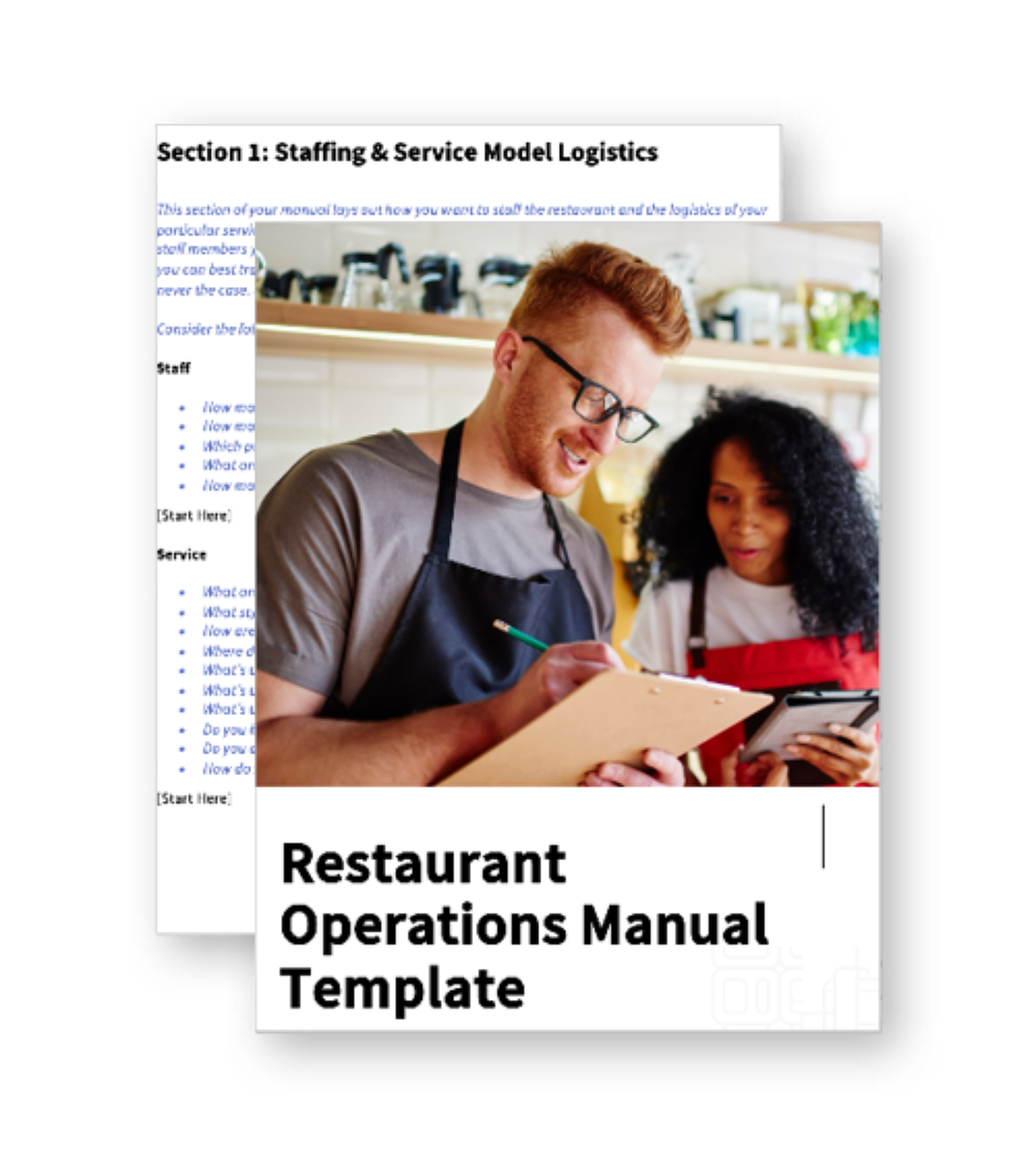
Your Guide for Writing a Restaurant Operations Manual
Learn how to put together a productive restaurant operations manual that helps you define how to run your business.

Tessa ZuluagaAuthor


Restaurant Operations Manual Template
Use this free template to easily outline all of your operating procedures and make day-to-day operations as consistent as possible.
Get free downloadAs they say, “There’s more than one way to cook an egg.”
As a restaurant owner, you know there's definitely a best way to cook that egg. You know that you’ll be doing it dozens, if not hundreds, of times per day. You’ve spent your career ensuring that your customers have the same best-cooked egg every day.
Your restaurant has a particular way of doing things. When things go right, you want to replicate it. When they go awry, you want to identify how to avoid those mistakes. An operations manual can help you do just that.
While not as interesting to write as a menu, a restaurant operations manual is no less important to how you run your business. In this article, we’ll outline:
What restaurant operations are
The importance of a restaurant operations manual
How to write an operations manual
Ready? Let’s dive in.
SOPs Template
This template will help you create SOPs for your entire business, so you can create consistency and easily train employees.

What are restaurant operations?
Operations include everything your restaurant business does. From how you set the table, the font you use for signage, and even how menu items should be plated. All of those decisions set the tone of your restaurant.
The steps you make to achieve that tone are your standard operating procedures. Those are referred to by their acronym – SOP. These SOPs make returning to a favorite restaurant so comforting.
Why? Because they’re consistent, and there’s not always a ton of consistency in the restaurant industry. In some cases, these pillars of consistency depend on one person or a tiny, long-term team. Of course, chaining yourself to your operation isn’t a healthy decision for you or your restaurant's future.
In a perfect world, your restaurant is reliable because your SOPs are well thought out and communicated to your teams. They make training new staff easier. They become habits that allow team members to focus on what matters most–serving your guests.
What is a restaurant operations manual?
A restaurant operations manual lays out the vision of your restaurant. This manual should be written carefully by restaurant management and have feedback from restaurant employees. A successful restaurant uses this manual to answer questions like: How do you want to treat your guests? How do you want to treat your people? What are your policies on food sourcing? Food handling and safety? Maintenance?
It sounds like a lot. And, it is. But, those SOPs are already happening. Your restaurant operations manual is just where you write them down.
SOPs live in a restaurant operations manual. You can’t rely on the procedures and guidelines for running the restaurant to be passed along via word of mouth. Putting these steps onto a shared document that is given out during employee training ensures this crucial information is available and, more importantly, used.
The importance of a restaurant operations manual
The restaurant work environment can quickly turn into a place for putting out fires. A restaurant operations manual is fire prevention. You’ve established SOPs that work for you, your team, and your guests. Write them down and use them. They’ll keep everyone on the same page and in the same direction. Guests will count on that high standard of consistency.
How to write a restaurant operations manual
1. Decide what to include
Your restaurant is unique. Even a multi-unit restaurant group should have a basic operations manual that caters to every location.
What you include in your operation manual is up to you. Consider your daily restaurant needs and day-to-day operations. Below are some great places to start. Add and subtract as your team sees fit. Remember - the way you prioritize these points says a lot about the culture of your restaurant. Once you’ve established what to include, keep the manual organized with a table of contents.
Staffing and service model logistics
This aspect of your manual lays out how you want to staff the restaurant. Think about various staff positions and how many you’d like to have. Include details of your training program and how new employees should onboard. How many training sessions does each position require?
Envision the best-case scenario. But, as we well know, that’s never the case. So, spell out how your operation can absorb those day-to-day realities.
Service logistics also illustrate how your guests interact with your restaurant. These logistics incorporate everything from where guests enter, how they’re greeted, to how they pay their bills. As with staffing, things are rarely perfect. Provide options for flexibility that won’t negatively impact your guests.
Opening & closing procedures
Your staff members should always be setting each other up for success. Whether they’re closing to set the morning crew up or opening to set up for the day, the process should be clear. You can break this section down between the front of house and back of house.
Front of House (FOH) opening & closing - The FOH has the most hands-on experience with guests, so it’s important to start the day off on the right foot to deliver great customer service. Every business is different, but consider including table setting, cleaning, restocking...etc. Keeping your dining area clean throughout the day is also important, consider implementing ongoing procedures as well.
Back of House (BOH) opening & closing - The back of house usually takes more preparation to open and longer to close. Consider your in-times for your kitchen staff. Considering including tasks to streamline your procedures like restocking ingredients, prepping food, and cleaning stations for the next cook.
Inventory and sourcing
A restaurant going through the trouble of writing an operations manual is probably already doing inventory. Yet, an accurate inventory is crucial. How and when you do that count is important. Your inventory SOPs should ensure accuracy but not depend on the same person doing that every time.
The same goes for sourcing. Those ordering details cannot live in your head. Provide a list of vendors and suppliers. Be sure to include contact details (salesperson, website, phone number,) how to place an order (via phone, website, app,) and updated pars.
Food preparation
An operations manual isn’t a recipe book. This manual should be about how you handle food as it enters your restaurant. Have a process for checking in orders. Train team members to put food and supplies away immediately and correctly.
There are also general SOPs for plating and packaging food as it leaves the kitchen. In addition, consider adding SOPs for disposing of food - e.a. how to deal with leftovers and where to document spoilage or breakage.
Maintenance and cleaning procedures
Great restaurants are clean restaurants. Maintaining that standard is a huge undertaking. It takes a team to pull that off. Divide this labor and define what to clean, when to clean it, and who will do the cleaning. Consider your entire “property” — parking spaces, sidewalks, windows, ceiling fans, hoods, bathrooms, stock rooms, staff areas. All of these spaces matter when assessing your restaurant’s cleanliness.
One common operation manual pitfalls are checklists. In this case, a checklist is a great solution. Keep them specific and updated.
Accounting and bookkeeping
Controlling your numbers is knowing your business. Keeping that consistency is so important. Juggling multiple software systems makes these steps convoluted. Using the right software solves those headaches. Be sure to include cash handling and tip-out protocols as well
Food safety
This is the rare instance where many restaurants are following the same SOPs. Resources for this are plentiful. You can find so much information on cross-contamination, service standards, and foodborne illness causes. Educate your team on these so food safety is more than a process, it’s something the staff understands.
This is a great chance to engage with your local food safety oversight. They can provide you with a ton of this information as a head start. It’s a smart move to introduce yourself to the sanitarian before they show up for an inspection too. They’re a resource – use them.
Your food safety materials are also a great place to place chemical safety data sheets. Those inspectors will love your restaurant for having those in such a prominent document.
Switchover operations
If your restaurant serves more than one meal a day, you know how chaotic switchover can be. With the night staff coming in, the daytime staff trying to cash out, and the kitchen switching ingredients over completely, it’s easy to get disorganized. To top it all off, you still need to give a good customer experience while food service continues during the switchover. Including a section for the switchover in your operations manual can help make this transition more efficient and help keep a strong dining experience.
Technology
You can’t operate your restaurant without it. Using the proper hardware and software might be your most important SOP. Use this section of the operations manual to remind team members how to access what they need – how to update changes to the menu, process sales when the internet is down, clock out, and clock in protocols.
Restaurant technologies have come a long way and provide valuable information to make the best decisions. Ensure your team is using your technology to its full extent.
2. Draft the guide
The good news is we made a template for you that’s completely editable. Download it here to make your one-of-a-kind restaurant operations manual template today. Remember, creating it all at once is too overwhelming - your days are too full to take on such a massive task.
So, take one of the sections from above and work on one SOP at a time. Don’t forget to get help from your team. This document is worth every second you spend drafting it!
3. Work with your team
You’re in charge, but you can’t do it alone. You can’t see all of the SOPs that exist throughout your restaurant. Enlist other managers, trainers, and trusted team members to help draft your manual. The dialogue will lead to SOPs with a broader point of view.
Also, any time you can engage team members to have a stake in the operation, it’ll be appreciated. Most importantly, this is a chance for you to acknowledge and thank the folks who’ve created successful SOPs by doing their job so well.
4. Publish and promote
Now that you have an operations manual, don’t let it linger on a clipboard in the office. Put it into action! It’s an integral part of your restaurant training manual and employee handbook. Make this a part of the onboarding of new hires. And, make sure to set an example by using it for yourself.
5. Update often
An operations manual is a living document. It needs to grow and change right along with the restaurant. Using your operations manual allows you to see where updates are necessary. Make those edits as you see them. It’s so much easier to adjust this in minor corrections than a massive redo.
Setting the Tone
The foundation of your restaurant isn’t your menu - It’s your operations manual.
You do things well. Your team does things well. Those successful habits are what make your restaurant unique. Call those habits SOPs. Collect them in an operations manual. Share that with your team and let them help run your restaurant how you need it to run.
Back of House Management Guide and Resource Kit
This guide and resource kit will help you develop an efficient back of house management system to ensure quality and consistency in your restaurant’s kitchen.

Is this article helpful?
DISCLAIMER: This information is provided for general informational purposes only, and publication does not constitute an endorsement. Toast does not warrant the accuracy or completeness of any information, text, graphics, links, or other items contained within this content. Toast does not guarantee you will achieve any specific results if you follow any advice herein. It may be advisable for you to consult with a professional such as a lawyer, accountant, or business advisor for advice specific to your situation.
Read More
Subscribe to On the Line
Sign up to get industry intel, advice, tools, and honest takes from real people tackling their restaurants’ greatest challenges.



